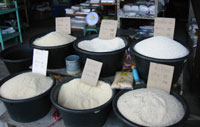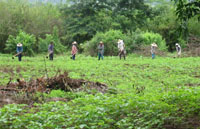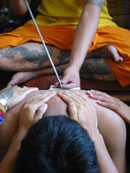Rice
Rice is the cornerstone of most any meal in Thailand. Before I came to this country, I was not a big fan of rice nor did I eat much of it. Rice sat in my cupboard and usually went stale. I knew next to nothing about rice varieties either, but cooking rice became a must in Thailand. Although I now know that white rice, brown rice, parboiled rice, glutinous rice and fragrant rice are the most common varieties found here, while out shopping and finding myself faced with dozens of bags to choose from, I usually scratch my head in confusion and select the bag with the nicest looking logo.
A frying pan may be the staple item of a Western kitchen, but in Thailand it is the rice cooker. These clever gadgets ensure that your rice is always perfectly cooked and will keep it warm throughout the day if you wish. Many a visitor to Thailand recognizes the practicality of these devices and returns home with one tucked under his or her arm. I was here for about five days before I’d bought one of my own.
one of my own.
Rice is an impressively versatile food and is prepared in a variety of ways simply too long to list. Rice makes its way into any meal, including breakfast. It is eaten plain, mixed with other foods, boiled, steamed, baked or stir-fried. It is eaten wet and sticky, light, fluffy and dry or watered down in a soup. Rice and fruit are commonly eaten for dessert, rice flour is made into cakes, bread, cookies and noodles, and let’s not forget rice wine!
Rice is the most important commodity in Thailand. This is reflected not only in the eating habits of the nation, but also in the landscape of the countryside. In the rice season of 1999-2000, it was reported that Thailand planted about 59.1 million rais (9.0 million hectares) of rice to produce 22.5 million tons of paddy, yielding roughly 15 millions tons of milled rice. Of this, approximately 9 million tons were used for local consumption, leaving about 6 million tons available for export. Rice represents 55-80% of total calories consumed by the population and the annual per capita consumption of milled rice in Thailand is estimated at an impressive 128 kg.
represents 55-80% of total calories consumed by the population and the annual per capita consumption of milled rice in Thailand is estimated at an impressive 128 kg.
Rice is not only eaten but also finds a number of other uses. Rice straw is made into baskets, hats, sandals, toys, and handicrafts and also woven into roofing material. Rice hulls are used as fertilizer and fuel and also added into building materials such as cement, bricks and blocks.
A tremendous amount of Thai culture concerns itself with rice and according to archaeological finds and plant remains, rice could have been cultivated in Thailand as early as 10,000 B.C. Folk songs, dances and festivals celebrate this important crop throughout the year. Artwork often illustrates villagers in the process of ploughing, sewing, harvesting or dehusking rice. Rice even has its own goddess in Thailand; her name is Mai Pho Sop. She is believed to live in grains of rice and is typically pictured holding rice stalks in one hand and a bag of seeds in the other. It is believed that Mai Pho Sop was born from rice, falls pregnant when the rice flowers, and then gives birth to rice. Rituals and gestures take place to ensure her well-being throughout the year, including offerings of food and shelter to her during the dry season.
Another event focusing on rice is The Royal Ploughing Ceremony, held at Sanam Luang at the start of the rice-planting season in May. This event is presided over with elaborate royal rites and features oxen at work, Brahmin priests sowing seeds, and the oxen divining the success of the next year’s harvest by auspiciously selecting from several types of food offered to them.
Although modernization of the agricultural industry has taken place, one can still see farmer and water buffalo working together in the rice fields; an image that is perhaps as endearing to locals as it is to tourists. Although rice farming is a celebrated event, the job of the rice farmer is often over-glorified and represents long hours toiling under the hot sun in less than wonderful conditions for very little money.
The Thai phrase ‘kin khao’ literally means to eat rice, although it refers to eating food of any kind. When eating in Thailand, it is common to take a bite of rice first before beginning the rest of your meal as a gesture that recognizes just how important rice is. The growing cycle of rice represents the happiness, health and wealth of the nation. The success or failure of this crop is dependant on the monsoon rains and in many ways the cycle of rice cultivation governs the cycle of life in Thailand.
